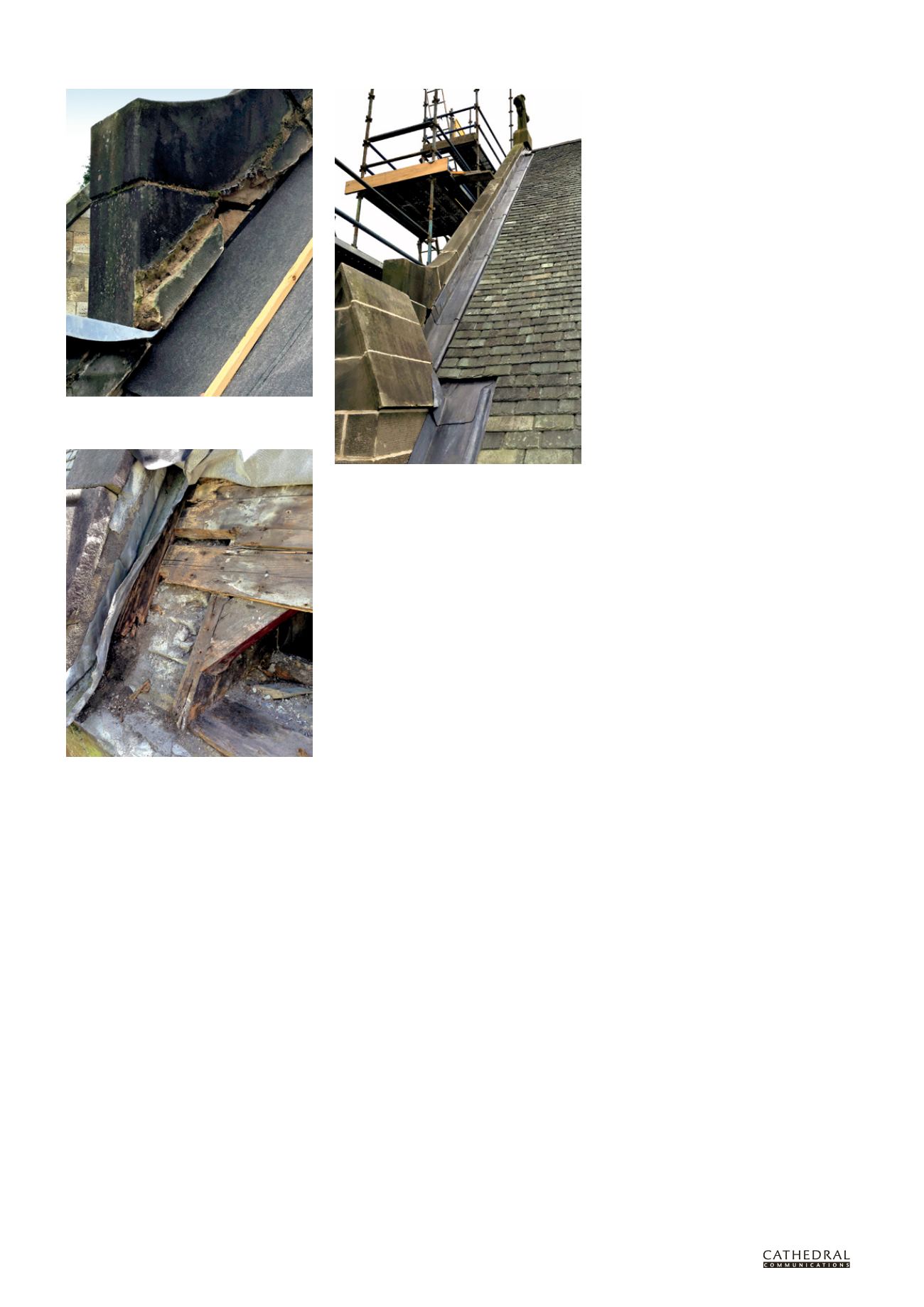

28
BCD SPECIAL REPORT ON
HISTORIC CHURCHES
24
TH ANNUAL EDITION
In some recent cases, bell-cotes or
pinnacles struck by lightning have even
fallen to the ground or through a roof. In
addition to the sudden and catastrophic
damage caused by storms, a constant and
challenging condition is dealing with the
consequences of increased rainfall, with
water penetration through stonework
and the strain on capacity of rainwater
disposal systems.
While the conditions in the west of
Scotland may be among the most severe
in Britain, the solutions and techniques
developed here will be of interest to
churches throughout the UK now
experiencing more frequent extreme
weather events.
As with all conservation work, the
starting point for church roof repairs is
a thorough survey, noting historic and
traditional details, and developing an
understanding of any weak points in the
envelope and its system of rainwater
disposal. When assessing the extent of
repairs required, regular issues are often
found that need not just repair, but more
robust details and solutions to withstand
the changing weather conditions. These
have to be carefully detailed using
traditional materials to be sympathetic
with historic fabric and to ensure long life
expectancy. Here the practical advice and
design details provided by the Lead Sheet
Association are invaluable, as is the advice
given on a rolling programme by Historic
Environment Scotland. The latter’s recent
publication
Short Guide 11 Climate
Change Adaptation for Traditional
Buildings
sets out the correct approach
to take when looking for a more robust
defence against severe weather.
LIGHTNING PROTECTION
It is surprising to find that many of the
churches do not have lightning conductors,
and a specialist assessment for a protection
system is now a routine ‘improvement’
to be considered. Lightning has become
more frequent in the west of Scotland
due to the warmer and wetter conditions.
The location and route of the conductor
cables can be discreetly positioned,
tucked into buttress internal corners,
run along the blind side of a ridge or
inside skews and then down to ground
terminals located appropriately away
from any graves in the church grounds.
FLASHINGS AND MORTAR FILLETS
Major problems often occur on the gable
walls where the up-stand skews are highly
exposed to wind and driven rain. The copes
that perform best have a projecting drip,
but many are eroded or were designed
without the drip. Wind-driven rain can
also penetrate the mortar bedding joints
and this may be improved by re-bedding
the cope stones on to a lead damp-proof
course and securely fixing them through
the lead to the wall-head. Skew abutment
flashings in particular have been failing
under the weather conditions with water
penetration causing damage to church
interiors. Aged leadwork which has had
to be dressed back repeatedly following
storms becomes malleable and brittle
with cracks developing, making it more
vulnerable to wind-lift.
On removing slates and skew flashings
it is common to find that the sarking
boards abutting the skew are rotten,
with a strip of decay up to one metre
wide. When water penetration has been
prolonged, the first rafter may also be
rotten if it is touching or close to the skew
stonework. Replacement sarking should
be formed with treated softwood timber
boards of the same thickness as the
original and preferably butt-jointed. Ply
sheet is not a suitable substitute because
it does not allow the same level of air flow
across the roof and it is difficult to nail
slates to it securely.
If stonework remains saturated
following prolonged periods of rain, damp
is likely to spread, penetrating the core of
the walls and damaging interior plaster.
A traditional detail found where skew
copes have shallow up-stands is a mortar
‘parging’ fillet, which can be badly affected
by cycles of saturation and wind-drying
that produce cracking. If it is not possible
to replace the fillet with a lead flashing, a
more robust alternative is to form a new
fillet over a stainless steel mesh that is
wedged into the skew bed.
Erosion of stone underneath lead
flashings can occur when the stone has
been under saturation conditions and
indents are often required to ensure a
sound base for new leadwork. The risk of
saturation may be reduced by increasing
the roof-cover width of the leadwork to
form a ‘watergate’ (a lead-lined channel)
with the upstand on one side and a
lead roll to the slate edge on the other.
This detail can greatly improve the safe
disposal of water and reduce seepage
and leaks into the sarking. An increase
to the up-stand of the lead flashing
and deeper cover flashing depth may
be considered if there has been stone
repair, but it may be more appropriate
to dress back into the original chase
to avoid weakening or damaging the
skew stonework. Traditionally, the
leadwork would be pointed in with a
lime mortar. However, with increased
Erosion of skew masonry beneath defective flashings,
with flush cope stones above
Rotten sarking caused by a failing skew abutment
A new ‘watergate’ with a lead skew flashing and a
storm roll to prevent storm water spreading into
the sarking


















